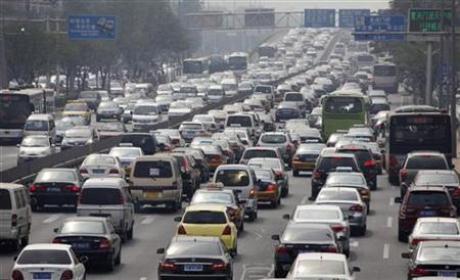What If Today's CO2-Emitting Devices Were The Last?
Date: 10-Sep-10
Country: USA
Author: Deborah Zabarenko

Cars are seen in a traffic jam in the second ring road in Beijing
September 9, 2010.
Photo: Petar Kujundzic
What would happen if cars, trucks, power plants and factories that now give off climate-warming carbon dioxide were allowed to die after their expected lifespans, and no new ones were built?
The answer is that the build up of greenhouse gases would fall short of the level that many climate scientists say would trigger the most devastating effects of global warming, researchers reported on Thursday in the journal Science.
It's not going to happen, but it's a hypothetical question researchers asked to try to figure out how much the planet would warm up if the current devices that spew this greenhouse gas were allowed to fade away.
If all these devices were allowed to lapse after their normal lifespans -- 40 years for a coal-fired power plant, 17 years for a U.S. late-model passenger vehicle -- it would raise the global mean temperature to 2.3 degrees F (1.3 degrees C) above pre-industrial levels.
That corresponds to a rise in atmospheric carbon to 430 parts per million, or ppm.
That is less than the 3.6 degrees F (2 degrees C) above pre-industrial levels, a dangerous level of global warming that many climate scientists have predicted could occur by 2100 if business continues as usual and the amount of carbon dioxide in the atmosphere rises to 450 ppm or more.
That 450 ppm number is significant, because many climate scientists and policymakers reckon that the worst effects of climate change -- sea level rise, severe storms, droughts and wildfires -- become more likely above this threshold.
For comparison, carbon in the atmosphere before the Industrial Revolution was probably between 270 and 280 ppm; it is now between 385 and 390 ppm.
INERTIA IN THE CLIMATE SYSTEM
The higher mean temperature is likely to come to pass by century's end since the odds of immediately stopping all production of fossil-fueled vehicles and factories are nil, said Steven Davis of the Carnegie Institution for Science, the study's lead author.
"We wanted to try to figure out, even if we never build another (carbon-emitting) device, are we already over these benchmarks that people talk about -- 450 ppm and 2 degrees C," Davis said. "It was a relative surprise to us that in fact the devices that exist today wouldn't put us over those benchmarks."
Climate scientists have focused largely on geophysical inertia in the climate system, the lag time between when greenhouse emissions occur and when they have a global impact, Davis said in a telephone interview.
But there are other types of inertia, he said, including the delay in cutting greenhouse emissions caused by long-lasting devices like most cars and factories that emit climate-warming carbon.
U.S. legislation to limit carbon emissions is mired in Congress. An international meeting on climate change set for Cancun, Mexico, later this year is not expected to provide any global policy breakthrough to curb greenhouse gases.
The next generation of energy infrastructure will be critical to limiting climate-warming emissions, the study's authors report, and a commentary article in Science called for more funding to develop new carbon-neutral energy technologies.
(Editing by Vicki Allen)